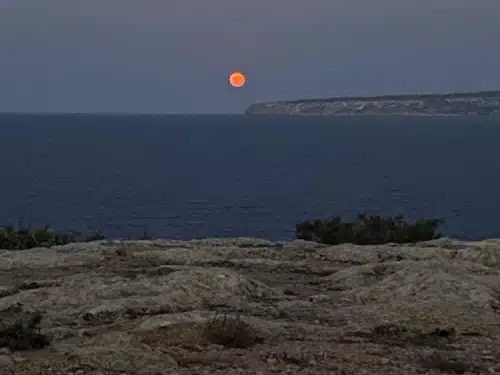

Formentera, September 3rd, 2025
This coming Sunday, September 7th, Formentera’s skies will treat us to a unique astronomical show: a total lunar eclipse. Although the event will begin while the Moon is still below the horizon, both locals and visitors to the island will have the chance to witness the final phase of the eclipse, with the Moon bathed in reddish hues over the Mediterranean Sea.
The “shame” about this eclipse is that, at the moment of its peak, the Moon will not yet have risen in Formentera, so we’ll miss the first part of the process. However, this gives the event a special touch: we’ll see the Moon rise already eclipsed, emerging from the horizon in a mysterious dark red glow.
These kinds of events, sometimes referred to as “blood moons,” occur when the Earth moves between the Sun and the Moon, casting its shadow on our satellite.
Sunlight passing through Earth’s atmosphere bends and colors the Moon in shades ranging from orange to deep red, depending on atmospheric conditions. As the night progresses, the Moon will gradually regain its usual brightness until it becomes fully visible again at around 22:55, when the penumbral phase ends.
Eclipse Phases in Formentera
In this section, I’ll try to summarize the eclipse phases to clarify what we’re expected to see – and what we won’t.
• 17:28 – Start of penumbral eclipse (not visible, Moon below the horizon).
• 18:27 – Start of partial eclipse (not visible).
• 19:30 – Start of total eclipse (not visible).
• 20:11 – Global maximum of the eclipse (still not visible).
• 20:12 – Moonrise in Formentera, already eclipsed.
• 20:16 – First moment of the eclipse visible from the island.
• 20:52 – End of total eclipse.
• 21:56 – End of partial eclipse.
• 22:55 – End of penumbral eclipse.
What will we actually see from Formentera?
The Moon will appear very faint and reddish over the horizon shortly after 20:12. Its brightness will be so weak that it might go unnoticed during the first few minutes, especially if the sky still holds some evening light. Between 20:30 and 20:50, the lunar disc will become more visible, though still wrapped in dark reddish tones.
Starting at 20:52, with the end of totality, the Moon will begin to recover its usual brightness, at first partially and then, after 21:56, almost as if nothing had happened. The show will come to an end around 22:55, when the Earth’s penumbra no longer affects the Moon.
Where to watch the eclipse?
If someone were to ask me where to go, my first recommendation would be the cliffs of La Mola, near the lighthouse. It’s easily accessible, has convenient parking, and offers plenty of space to choose the perfect spot to sit and enjoy the event.
Another spot I recommend is the cliffs of Punta Prima, where you can enjoy the sunset to the west and the rising eclipsed moon to the east. Plus, the 18th-century defense tower will be there as a silent companion.
Another great place to watch the eclipse is the Es Cap de Barbaria lighthouse, offering a wide and unobstructed view of the Moon’s rise over the horizon that evening. Keep in mind, though, that access by car or motorbike is closed off a kilometer and a half before reaching the lighthouse, so you’ll have to walk that stretch both ways — but it’s well worth it after witnessing a lunar eclipse in Formentera.

I’m Ramón Tur, the person behind everything written and photographed on this website about Formentera. I discovered the island in 1972 when my parents, aboard the mythical Joven Dolores, took me on vacation from Ibiza for the first time, and it was love at first sight that has only grown stronger over time, making Formentera my place of residence for many years now. If you wish, you can follow me on Instagram @4mentera.com_
If you're planning to visit Formentera, make sure to check out our discount codes section first.





